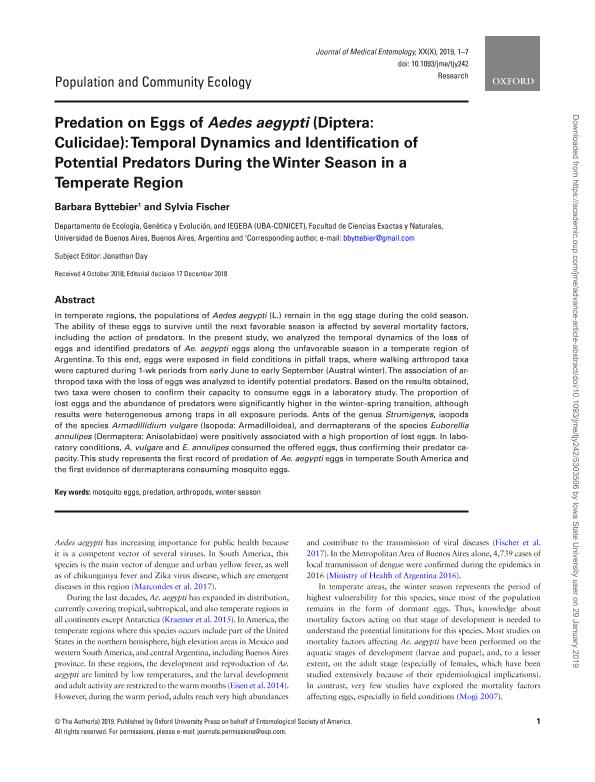Artículo
Predation on Eggs of Aedes aegypti (Diptera: Culicidae): Temporal Dynamics and Identification of Potential Predators During the Winter Season in a Temperate Region
Fecha de publicación:
05/2019
Editorial:
Entomological Society of America
Revista:
Journal of Medical Entomology
ISSN:
0022-2585
Idioma:
Inglés
Tipo de recurso:
Artículo publicado
Clasificación temática:
Resumen
In temperate regions, the populations of Aedes aegypti (L.) remain in the egg stage during the cold season. The ability of these eggs to survive until the next favorable season is affected by several mortality factors, including the action of predators. In the present study, we analyzed the temporal dynamics of the loss of eggs and identified predators of Ae. aegypti eggs along the unfavorable season in a temperate region of Argentina. To this end, eggs were exposed in field conditions in pitfall traps, where walking arthropod taxa were captured during 1-wk periods from early June to early September (Austral winter).The association of arthropod taxa with the loss of eggs was analyzed to identify potential predators. Based on the results obtained, two taxa were chosen to confirm their capacity to consume eggs in a laboratory study. The proportion of lost eggs and the abundance of predators were significantly higher in the winter–spring transition, although results were heterogeneous among traps in all exposure periods. Ants of the genus Strumigenys, isopods of the species Armadillidium vulgare (Isopoda: Armadilloidea), and dermapterans of the species Euborellia annulipes (Dermaptera: Anisolabidae) were positively associated with a high proportion of lost eggs. In laboratory conditions, A. vulgare and E. annulipes consumed the offered eggs, thus confirming their predator capacity.This study represents the first record of predation of Ae. aegypti eggs in temperate South America and the first evidence of dermapterans consuming mosquito eggs.
Palabras clave:
ARTHROPODS
,
MOSQUITO EGGS
,
PREDATION
,
WINTER SEASON
Archivos asociados
Licencia
Identificadores
Colecciones
Articulos(IEGEBA)
Articulos de INSTITUTO DE ECOLOGIA, GENETICA Y EVOLUCION DE BS. AS
Articulos de INSTITUTO DE ECOLOGIA, GENETICA Y EVOLUCION DE BS. AS
Citación
Byttebier, Bárbara; Fischer, Sylvia Cristina; Predation on Eggs of Aedes aegypti (Diptera: Culicidae): Temporal Dynamics and Identification of Potential Predators During the Winter Season in a Temperate Region; Entomological Society of America; Journal of Medical Entomology; 56; 3; 5-2019; 737-743
Compartir
Altmétricas




